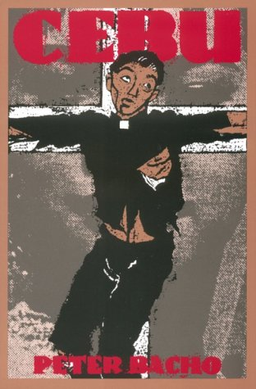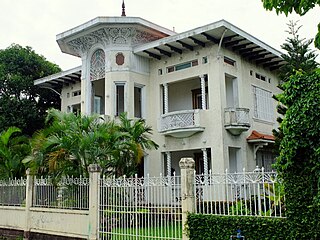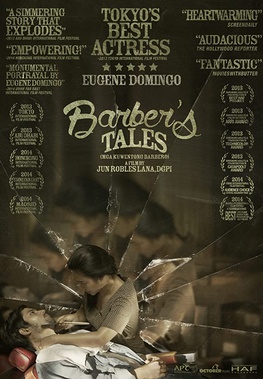
Cainta, officially the Municipality of Cainta, is a 1st class urban municipality in the province of Rizal, Philippines. According to the 2020 census, it has a population of 376,933 people.
The Kapampangan people, Pampangueños or Pampangos, are the sixth largest ethnolinguistic group in the Philippines, numbering about 2,784,526 in 2010. They live mainly in the provinces of Pampanga, Bataan and Tarlac, as well as Bulacan, Nueva Ecija and Zambales.
The Zóbel de Ayala clan is a prominent Filipino family of Spanish and German descent who were the founders of Ayala y Compañía and patrons of the Premio Zóbel literary awards. The clan is directly descended from Jacobo Zóbel y Zangroniz (1842–1896) and Trinidad de Ayala (1856–1918). Ayala y Compañía traces its origins to Casa Róxas, a business partnership established in 1834 between Domingo Róxas (1792–1843) and Antonio de Ayala (1803–1876).

The Manila massacre, also called the Rape of Manila, involved atrocities committed against Filipino civilians in the City of Manila, the capital of the Philippines, by Japanese troops during the Battle of Manila which occurred during World War II. At least 100,000 civilians were killed in total during the battle from all causes including the massacre by Japanese troops.

Alejandro Reyes Roces was a Filipino author, essayist, dramatist and a National Artist of the Philippines for literature. He served as Secretary of Education from 1962 to 1965, during the term of Philippine President Diosdado Macapagal.
Nora Guanzon Villanueva-Daza, popularly known as Chef Nora Daza, was a Filipino veteran gourmet chef, restaurateur, socio-civic leader, television host, and best-selling cookbook author. Daza was considered as the Philippines' first culinary icon, and was also known as the "Julia Child of the Philippines" and the Philippines' first "culinary ambassador".
Tess Uriza Holthe is a Filipino-American writer, who was born and raised in the Bernal Heights neighborhood of San Francisco and is best known for her nationally bestselling novel When the Elephants Dance.
Rodolfo Valentino Padilla Fernandez, better known as Rudy Fernandez or Daboy, was a Filipino actor and producer. He came to prominence as an action star in Philippine cinema during the 1980s up to the early 1990s.

Cebu is a 1991 novel by Filipino American author Peter Bacho the "most visible figure" of second-generation, native-born Filipino American writing and one of several Seattle novelists in the 1990s to explore the racial history and sociology of Seattle. The novel is also "the first novel about a Filipino American who identifies primarily with US localities," rather than with the Philippines.

May Minamahal is a 1993 Philippine film produced by Star Cinema and was turned into a TV series by ABS-CBN which was aired from June 4 to July 13, 2007. It is the third installment of Sineserye Presents.

May Minamahal is a 1993 Filipino romantic comedy-drama film written and directed by Jose Javier Reyes. It is the first romantic drama film produced by Star Cinema, and its third film overall. Its rough translation in English is "Loving Someone". Starring Aga Muhlach and Aiko Melendez in their first film together in leading roles, the film revolves the romance between a young man who is the only son of an all-female family and a young girl who is the only daughter of an all-male family. It also stars Boots Anson-Roa, Ronaldo Valdez, Claudine Barretto, Agot Isidro, Nikka Valencia, John Estrada, Aljon Jimenez, and Ogie Diaz.

Tatlong Taong Walang Diyos is a 1976 Filipino period film written and directed by Mario O'Hara that set in the province of Laguna during the Second World War. The film stars Nora Aunor as the barrio lass Rosario, Christopher De Leon as the Japanese-Filipino army officer Masugi, and Bembol Roco as the army guerilla member Crispin.
The Congregation of the Dominican Sisters of St. Catherine of Siena is a Dominican congregation of religious sisters under the patronage of St. Catherine of Siena. It was founded by Father Juan de Sto. Domingo, OP and Mother Francisca del Espiritu Santo de Fuentes in 1696 for Spanish women only.

On May 14, 2008, the two-storey Gala–Rodriguez house was declared by the National Historical Institute of the Philippines as one of the three heritage houses in Sariaya, due to its notable historical and cultural significance. Designed by Dr. Juan Nakpil in the early 1930s, it was owned by one of the most distinguished couples in Quezon, Dr. Isidro Rodriguez and Doña Gregoria Gala. The house is located in Rizal Street along with other opulent houses owned by the illustrados of old Sariaya. It is listed as one of the Ancestral Houses in the Philippines, under Region IV-A.

Barber's Tales is a 2013 Filipino drama film by Jun Robles Lana. The film stars Eugene Domingo as Marilou, a widow who is forced to take her late husband's job as community barber during the end of Marcos era. The film is the follow-up to Lana's film Bwakaw and second of a trilogy focused on the small-town life in the Philippines. The film had its world premiere and competed at the 2013 Tokyo International Film Festival, where it won the Best Actress Award for Eugene Domingo's performance.
Bonifacio Lopez Mencias was a Filipino physician, epidemiologist, guerrilla sympathizer, and martyr. He is best known for providing aid to the Philippine guerrillas in his capacity as Dean of the UST Faculty of Medicine and Surgery during the Japanese occupation of the Philippines – an act which led his capture and presumed death at the hands of the occupying forces just before the liberation of Manila.
Juan Querubin Miranda was the first Representative of the 1st District of Camarines Sur, (1946–1949) in the 1st Congress of the Commonwealth of the Philippines. Before the onset of World War II, he was a sergeant with the Philippine Army assigned in Legazpi City. He also headed the Tancong Vaca Guerilla Unit organized by him and by two of his fellow Canaman townmates Elias Madrid and Leon SA. Aureus.

Barangay 143 is a Japanese-Filipino-Singaporean anime television series produced by ASI Animation Studio, Sunrise Studio and Shin-Ei Animation. Announced in 2016, the first season premiered on October 21, 2018, in the Philippines on GMA Network and worldwide on GMA Pinoy TV.
Naomi Flores (1921-2013) was active in the Philippine resistance to the Japanese occupation of the Philippines in World War II. Flores was a member of the "Miss U Spy Ring." Working clandestinely and at great risk to herself, she delivered life-saving supplies and messages to American and Filipino prisoners of war in prison camps. She later married an American and moved to the United States. She was honored by the United States with a Medal of Freedom in 1948.

Valeria "Yay" Panlilio (1913–1978), known as Colonel Yay, was an American/Filipina journalist, radio announcer, and guerrilla leader during World War II in the Philippines. After the war she married the commander of Marking Guerrillas, Marcos Villa Agustin. She was awarded the United States Medal of Freedom for her wartime activities.









